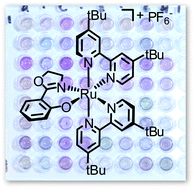Discovery of a strongly apoptotic ruthenium complex through combinatorial coordination chemistry†
Abstract
A strategy for combinatorial parallel coordination chemistry is introduced that provides access to libraries of tris-heteroleptic

* Corresponding authors
a
Fachbereich Chemie, Hans-Meerwein-Strasse, Marburg, Germany
E-mail:
meggers@chemie.uni-marburg.de
Fax: (+49) 6421 2822189
Tel: (+49) 6421 2821534
b
Kinderkrankenhaus, Kliniken der Stadt Köln gGmbH, Amsterdamer Str. 59, Köln, Germany
E-mail:
prokopa@kliniken-koeln.de
Fax: (+49) 221 89075395
Tel: (+49) 221 890715121
A strategy for combinatorial parallel coordination chemistry is introduced that provides access to libraries of tris-heteroleptic

 Please wait while we load your content...
Something went wrong. Try again?
Please wait while we load your content...
Something went wrong. Try again?
S. P. Mulcahy, K. Gründler, C. Frias, L. Wagner, A. Prokop and E. Meggers, Dalton Trans., 2010, 39, 8177 DOI: 10.1039/C0DT00034E
To request permission to reproduce material from this article, please go to the Copyright Clearance Center request page.
If you are an author contributing to an RSC publication, you do not need to request permission provided correct acknowledgement is given.
If you are the author of this article, you do not need to request permission to reproduce figures and diagrams provided correct acknowledgement is given. If you want to reproduce the whole article in a third-party publication (excluding your thesis/dissertation for which permission is not required) please go to the Copyright Clearance Center request page.
Read more about how to correctly acknowledge RSC content.
 Fetching data from CrossRef.
Fetching data from CrossRef.
This may take some time to load.
Loading related content
